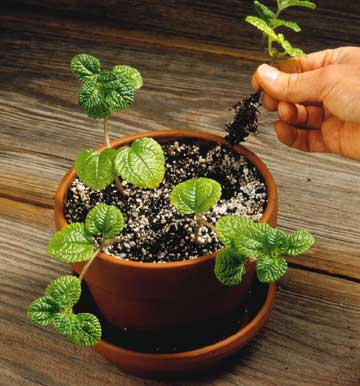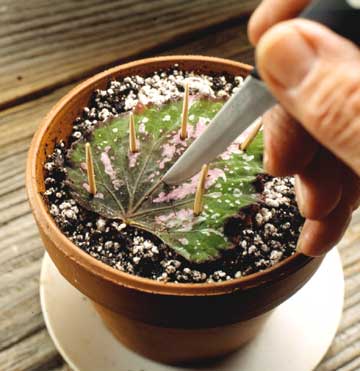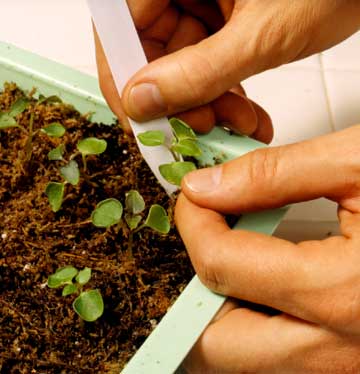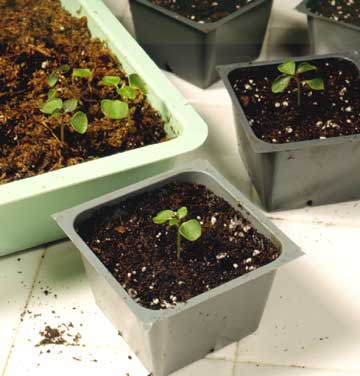





The growing tips of many plants will produce vigorous new plants when cut and rooted properly.
continue reading below Step 1
Step 1
1. To propagate new plants from most multistemmed houseplants, try rooting tip cuttings. First, cut 4 to 6 inches from the tip of the main stem or side branch. Cut just below a node (where leaf and stem meet).
 Step 2
Step 2
2. Remove the lower leaves and any flowers. Dust cut ends with rooting hormone powder, then plant in moist rooting medium (half peat moss, half perlite works well); keep leaves above soil. Or, skip powder and place in water.
 Step 3
Step 3
3. Provide indirect light and bottom heat. When cuttings resist tugs, they are taking root. Dig up gently, check root growth, and pot up. Move cuttings in water to another rooting medium as soon as roots sprout; pot up.
Once you've propagated your plant, click here to learn how to use plant grow lights to keep it healthy.
 Easily expand the number of plants in your home by dividingthe ones you already have.
Easily expand the number of plants in your home by dividingthe ones you already have.
Many houseplants produce several stems with roots attached to each stem. Each of these rooted stems can be divided from the parent houseplant to make a new plant.
You can divide to make two or more plants from any that have multiple stems coming up from the soil surface. Pull or cut the plants apart. Each section must have a cluster of roots. Pot each section in fresh potting mix.
Learn how to make your own potting mix.
 Step 1
Step 1
1. To divide a multistemmed houseplant, first remove the plant from its pot. Early spring generally is the best time to divide plants. Press your thumbs into the middle of the plant, grab the plant with both hands, and tug it apart. If this doesn't work, remove the soil and try again. If that fails, cut the plant with a knife.
2. Keep a large clump of roots with each division. Immediately pot the new plants in potting soil. Keep the soil evenly moist for the next few weeks to help heal the injured roots.
3. Place plants out of direct light until they start to grow. Move them into brighter light over a period of 10 days.
Dieffenbachias and similar plants often lose lower leaves. When this happens, cut top off and propagate new plants.
Cut plant about 15 inches below bottom leaf; root in water. Pot when roots form. Cut rest of stems into short lengths, each with a node. Place horizontally in moist medium, covering node with soil. New plants will emerge.
 African Violet
African Violet
To propagate an African violet, take at least an inch of stem with each leaf. Insert the stems into water or a peat-based mix. Pot leaves that have been in water as soon as roots form. Pot others when roots are established.
 Rex Begonia
Rex Begonia
To propagate a rex begonia, set a healthy leaf, top side up, on moist growing medium. Sever a few of the veins. Pin the leaf down so the cuts come in contact with the medium. Keep moist. Pot the plantlets that grow from each cut.
 Snake plant
Snake plant
To propagate a snake plant, cut a leaf into sections; indicate with angled cuts which end is bottom. Dip bottom ends in rooting powder; insert in moist rooting medium. Pot new plants that form to sides of leaf sections.
 Step 1
Step 1
1. Make an upward cut into the stem just below a node, at a point where you'd like new roots to grow. Cut halfway through the stem. Place toothpick or matchstick into cut to keep it open. Dust area with rooting hormone powder.
 Step 2
Step 2
2. Place moist moss around the cut and secure it with plastic. Wrap wire twists at top and bottom. Undo top; mist moss regularly. When roots are thick, cut stem several inches below original cut; pot.
Plants that send out aerial runners and form new plantlets are easy to propagate.
When age takes its toll on a spider plant, it's time to root the plantlets and start over. Spider plants often become straggly. Their natural inclination is to produce new foliage and shed the old.
To root plantlets that form on aerial runners, set pots filled with rooting medium nearby. Pin plantlets into medium with hairpins. Keep moist. Once plantlets root, sever stems to parent plant.

Seeds are an inexpensive and satisfying way to start many houseplants, including asparagus fern, bromeliads, cacti, coleus, gloxinia, impatiens, and kalanchoe. But, because your plants won't be of display size for many months, you'll need patience.
1.Fill tray or pot with sterile medium, mist with water, then top with 1/4 inch of milled sphagnum moss. Press moss with a book. Sprinkle seeds across moss surface or into shallow rows.

2. Cover larger seeds with a sprinkling of moss. Pat small seeds into moss. Mist again. Cover tray with glass or plastic; place on heating pad or top of refrigerator. Place in light suggested on packet. Mist when moss begins to dry.

3. Remove glass when seedlings pop through moss. Move seedlings to brighter light. Transplant when second set of leaves develops. Dig seedlings up gently, holding by one of the leaves, not the stem.

4. Give each seedling its own small pot, filled to within 1/2 inch of top with light soil. Firm the soil around the base of each stem, making sure not to bury the leaves. Water immediately. Move plants steadily into brighter light.
Learn more about starting seeds.
Copyright © www.100flowers.win Botanic Garden All Rights Reserved